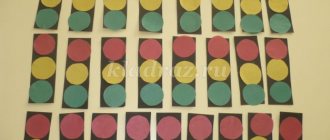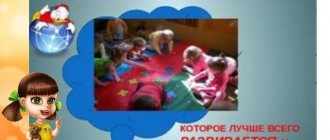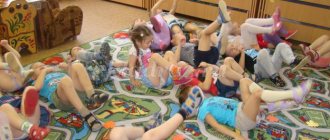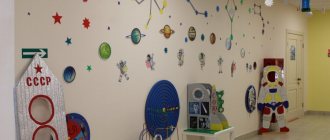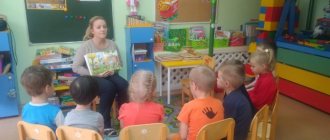Methodological techniques for conducting theatrical games
In the middle group, the standard set of techniques for organizing play activities for children has a number of features.
Verbal techniques
Children aged 4–5 years improve their speech skills, while the educational program provides for certain correctional work aimed at correcting possible speech defects. We can say that theatrical games, based on children communicating with each other and with the teacher, are of a speech therapy nature, as they allow children to “speak out” and at the same time copy the speech patterns of adults. Such a responsible role as a teacher requires not only competent, well-delivered speech, but also following the rule of repeating instructions 2-3 times, if possible, with the same set of linguistic means.
Conversation and explanation
Communication with little whys is the basis of the educational process. If the explanation begins the game, updating the students’ basic knowledge, then the conversation accompanies the entire game process. At the same time, the questions that the teacher asks are no longer only of a reproductive nature, but also of a problematic nature. For example, “Did the animals do the right thing when they let the Bear into the mansion?”, “How can we explain that the heroes managed to pull out the turnip?”
In addition, conversation is also important when considering issues related to theatrical topics. For example, after getting acquainted with theatrical professions, the teacher checks in a dialogue form how well the children have learned the material: “Who applies makeup to the actor?”, “Who tells the actors how to act on stage?”
The teacher explains the description of all game actions
Riddles and poems
As a rule, these techniques are used to motivate children to work, since they allow children to switch their attention from one type of activity to another and at the same time captivate them so much that almost all children are involved in theatrical activities at once.
In my experience, I often resort to riddles. Especially before games on the flannel. So, for example, before acting out the plot of the fairy tale “Kolobok”, I invite the kids to guess the riddles:
- The ruddy mischievous man left his grandmother, and instantly wandered along the path into the dense forest. He met a hare, a wolf, he met a bear, and for the cheating fox, Alas, he became lunch. (Kolobok),
- He has long ears. The first one met on the way at the kolobok. I tried, but didn't eat it. (Hare),
- The red-haired sly Kolobochka swallowed... (Fox).
In the middle group, riddles can already be without agreements and do not necessarily rhyme.
For a number of games, poems are an appropriate motivational device. At the same time, the most important aspect of choosing texts is their volume: rhymes should be short, otherwise the children will be distracted and will not be able to concentrate on the game.
So, in our practice, before the role-playing scene “In the Store”, together with the kids, we repeat the poems we learned while getting to know the world around us:
- "Salesman". Discounts in our store! All products are on display. I'll give you good advice and select a model and color.
- "Shop". They bring food to the store, but not vegetables or fruits. Cheese, sour cream and cottage cheese, Glazed cheese. Three cans of milk were brought from afar. Children love our Yoghurts and curdled milk. This is very useful for them. Our store is a dairy store.
Short stories
Literary plots are a traditional illustration of the game: children listen to a fairy tale, discuss it, and then, based on the text, engage in play activities. But to motivate kids, you can also use stories invented, as they say, on the fly. The advantage of such stories is that they can be tailored to any theme, especially if the game is based on a long-known plot.
For example, while working on the dramatization of “Zayushkina’s Hut,” I tell my students a story about a mouse who found himself in the same situation as the hare from the fairy tale: “Once upon a time there was a Little Mouse. He was hardworking and kind. And his distant relative Hamster, on the contrary, is envious and lazy. One day the Hamster came to visit the Mouse, saw his spacious hole and began to complain that his house was completely leaky, the rain was wet, the wind was blowing. The Mouse took pity on the poor Hamster and offered to stay. And the ungrateful Hamster kicked the owner out into the street a week later. But the Hedgehog met the Mouse, found out why he was upset, went and drove the Hamster away. A few days later, the Hamster came to visit again, apologized, and gave the Mouse a beautiful blanket to keep him warm in winter. The Hamster said that he realized how badly he had acted, boasted that he had built himself a house and invited the Mouse to visit.” The fairy tale ends with 2-3 questions: “Is the Mouse a positive or negative character?”, “Why is the Hamster’s action bad?”, “Did the Hedgehog do the right thing by standing up for the Mouse?”
Visual techniques
Without influencing the visual channel of perception when working with preschoolers, for whom visual-figurative assessment of the world around them is the leading one, it is impossible to achieve the necessary results.
Illustrations
Pictures, photographs with theatrical themes (elements of costumes, false hair, noses, cheeks, etc.) or with plots of games are a mandatory element of clarity.
These materials can be collected in booklets or lapbooks - folders with materials (informational articles, crosswords, games, etc.) that reveal the essence of any aspect of theatrical art, for example, “The History of Puppet Theater.”
Lepukki can be dedicated to specific types of theater
Demonstration
This type of visual techniques includes:
- showing videos of games (for example, how children of the same age perform actions according to the terms of the game),
- the teacher plays out actions on behalf of all the characters (for example, in the game “In the Store” the teacher plays out the actions of both the seller and the buyer),
- visiting the local theater.
Gaming accessories
As in the classical sense of theater, theatrical activities in kindergarten require the presence of props. As a rule, it is presented in the required volume in the theater zone of the subject-developmental environment of the group. Read about how to properly organize this environment here: “How to creatively and methodically correctly design a theater corner in a kindergarten.”
Dwelling on the standard, minimal set of attributes for games, it should be noted that it includes:
- screen (table and floor, serving as a universal decoration, for example, a castle and a mansion),
- masks with painted animal faces (such masks can be made from cardboard or using the papier-mâché technique),
- paper or cardboard hats with pictures of fairy-tale characters (grandmother, grandfather, cat, etc.),
- puppets (glove, finger)
- decorations made from waste material (acorns, matches, etc.),
- pictures on a hard base for acting out scenes on a stand (flannelograph or magnetic board),
- dolls on spoons, plastic cups,
- costumes or individual elements for the children to act out scenes (sundress, scarf for grandmother, bloomers for grandfather, yellow scarf for turnip, etc.).
Props for role-playing games can be used in different productions
Group of practical techniques
These are all types of work that carry the materialization of creative ideas:
- drawings,
- applications,
- plasticine crafts,
- projects (work to highlight topics related to theatrical activities, carried out jointly with parents).
However, in addition to the above, the group of practical techniques includes two more, used specifically in theatrical games: tasks for social-emotional development and psycho-gymnastics.
Exercises for social-emotional development
The essence of these tasks is that the children learn to coexist with the world around them in situations outlined by the game conditions.
The simplest exercise I use with preschoolers of all ages is the “Giving Emotions” exercise. The essence of the task is to show certain experiences and repeat what was shown by your comrades. After the demonstration, the children discuss which emotions were pleasant to show and which were unpleasant and why.
Psychogymnastics tasks
The purpose of these exercises is reflection after the game. As a rule, psycho-gymnastics is performed to calm, soothing music.
In my work, I use the “Mood and Nature” exercise: we close our eyes, imagine ourselves on the seashore, it’s warm - we feel calm, we go into the water, it’s cool - a little anxious, the wind picks up - we become anxious, the sun comes out, it’s warm again - joyful.
Psycho-gymnastics is designed to relieve muscle tension after active play.
